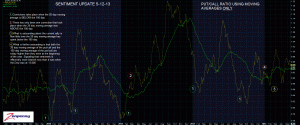THIS SENTIMENT INDICATOR JUST REFUSES TO GIVE BEARS WHAT THEY WANT
What is it about the current market that has left so many otherwise intellectually esteemed individuals dumbfounded when it comes to proper allocation of assets? Admittedly, this has been a difficult market to keep up with if the quality of your work is predicated by your ability to keep up with a benchmark. Without passing judgment or exercising bias of any sort let's look at exactly what is going on in the market as of the close Friday. Again, no passing judgment or exercising bias. Simply a look at what is occurring in 2013:
- Dow is at an all-time high
- S&P 500 is at an all-time high
- Russell 2000 is at an all-time high
- Nasdaq Composite is at a 10+ year high
- Dow Transports are at an all-time high
- NYSE Healthcare Index is at an all-time high
- XLP - Consumer Staples ETF is blazing a new all-time high each week
It is not just market strength we are talking about so far in 2013, it is strength in key sectors that typically attract a large international, institutional presence. Joe Smith from Wichita, Kansas doesn't wake up one day to turn on CNBC seeing that the markets are hitting new highs and put in a buy order for Kellogg or Colgate Palmolive. It is the institutional money that is seeing increased demand for a properly performing asset class that doesn't have an increasing potential for debt orchestrated periods of shock and awe to the downside that is buying up these names.
It is not just any institutional investor either. It is Asian, European and Latin American institutions, alongside US firms that are piling into these names. The prototypical image of a rally of this nature being led by a bunch of dummies simply doesn't apply here. Those of you who are constantly drawn to this image need to rewire your synapses to correspond to the present day. This isn't the 90s or the 2000s. It is an entirely different market ecosystem that instilled enough fear and hate for equities into the masses that they are perfectly fine with allowing all-time highs to become nothing more than a news event, as opposed to anything having to do with enhancement of their overall net worth.
When the general public does return to the market their footprints will be clear. Speculative stocks will rise in a manner that is disproportionate with any positive fundamental developments. Buying becomes sloppy. Pullbacks become more difficult to gauge accurately. The entire infrastructure of the market becomes increasingly unstable as a result of the erratic participation this class of investor brings with it.
We are nowhere close to this stage of the rally. The psychological scars run too deep as a result of a perception of Wall Street as a deceptive, untrustworthy and even fraudulent segment of finance that is best left to testosterone driven men who enjoy hair gel, scotch and the olive bar at Whole Foods.
We all know that markets don't go up forever. Furthermore, we all know markets that tend to portray an overwhelming sense of safety and stability tend to have the most violent pullbacks over the short-term. Now that every major index has blown through its long-term resistance levels, we are left to look at a combination of price action and the resulting sentiment to come to any educated conclusion as to when a pullback may strike.
There is one indicator in particular that I have been pointing to as a means of gauging when sentiment is becoming overly-optimistic and careless. This indicator has a superb track record for gauging corrections within the bull market that started in 2009. Let's have another look at the put/call ratio using the 20 day and 100 day moving average only. One glaring point that continues to be a poke in the eye of the bears is that the 20 day moving average has crossed back over and above the 100 day moving average, meaning that sentiment can still be classified as bearish technically speaking. I'll be updating this chart frequently over the next few months:
click chart to enlarge


